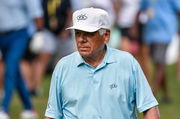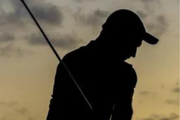

As the golf world converges on Oakmont for the 2025 U.S. Open from June 12 to 15, there’s a lingering question hanging heavy in the Pennsylvania air: Can the USGA still stage a true, old-fashioned U.S. Open—one that tames the modern bombers instead of being steamrolled by them? Few understand that tension better than veteran golf writer Alan Shipnuck, both infamous for his very public feud with Phil Mickelson and widely respected for his unfiltered takes. Speaking with Dan Rapaport live from Oakmont on Dan on Golf, Shipnuck didn’t hold back as he dissected the USGA’s long-awaited distance rollback and the state of modern major championship golf.
Watch What’s Trending Now!
To Shipnuck, Winged Foot was the moment the dam broke. “Well, and you know, Bryson said the quiet part out loud when he… when he just emasculated Winged Foot. Killed it,” Shipnuck said. “And you know, that was the scene of the massacre — Winged Foot had an aura, like Oakmont — and Bryson destroyed the aura with his golf clubs and his mouth.” Back in 2020, Bryson DeChambeau arrived at Winged Foot with a radical strategy: bulked up, swinging out of his shoes, and fully embracing the bomb-and-gouge approach. On a course historically known for humbling the field—Geoff Ogilvy won at +5 in 2006—DeChambeau shredded it, finishing at 6-under-par and winning by six shots. He was the only player in red figures that week, essentially rewriting how a U.S. Open could be won.
Since then, the conversation has only intensified as players like Rory McIlroy, Cameron Young, and now Ludvig Aberg have joined the new generation of heavy hitters who make 7,500-yard courses look pedestrian. Even Oakmont—with its lightning-fast greens, penal rough, and church-pew bunkers—may not be enough. “And we know that these guys hit the ball too far,” Shipnuck continued. “That it’s ironic that at the USGA’s crown jewel championship, their dereliction of duty becomes so apparent when the players are just… just overpowering every golf course. And so this is kind of the last chance for an old-fashioned U.S. Open — because if you can’t get it at Oakmont, you can’t get it anywhere.”
ADVERTISEMENT
We’re coming to you LIVE from Oakmont for a special U.S. Open preview edition of @danongolfshow!
Guests include:@alanshipnuck@cpowers14@_raymondw@usga‘s Jeff Hall
Watch now! https://t.co/X3y41TzxBx
— Skratch (@Skratch) June 11, 2025
That “dereliction of duty” he’s referring to? The USGA’s long-delayed golf ball rollback, scheduled to take effect in 2028, will limit how far balls can fly under specific testing conditions. The rule change adjusts testing speeds from 120 mph to 125 mph, aiming to trim 13–15 yards off elite drivers. But in Shipnuck’s view, that’s barely a scratch. “It’s so trifling,” he said. “I mean, you’ve got to roll it back 25%, because just by messing with shafts and launch angles and everything, they’re going to… they’re going to get back to where they were within months. It’s just not enough. It was maybe a symbolic effort, and maybe that’s just the first shot in a larger war. But the rollback, as it stands now, is going to have a trivial effect.”
The USGA maintains that the rollback is about preserving the game long-term. But as this year’s U.S. Open kicks off, Oakmont—the site of some of golf’s most punishing history—will be tested just as much as the players. If it can’t hold up, Shipnuck warns, then maybe nothing can. With the stage set for what could be a defining moment in the distance debate, all eyes now turn to the players who will battle both the course and the controversy.
ADVERTISEMENT
Top Stories
Lee Trevino, 86, Leaves Golf World Hanging on Every Word at PNC: ‘I’ve Been Digging Worms’

Paige Spiranac Shares Her Mom’s Honest Views on Controversial Career Decisions

‘Losers’: PGA Tour Pro Blasts Fan Behavior After Viral NFL Arena Incident

LIV Golf Issues Statement as Pro Announces Shock Retirement After Getting Relegated

Korean PGA Tour Star Clears the Air on LIV Golf Rumors With Blunt Message

Who to watch at the 2025 U.S. Open?
The 2025 U.S. Open field is stacked with star power and brewing rivalries that could define this year’s championship. Scottie Scheffler leads the charge, entering Oakmont as world No. 1 with a dominant run that’s seen him win three of his last four starts, including the PGA Championship. Right behind him is Bryson DeChambeau, the defending U.S. Open champion who rewrote the blueprint for major success with his overpowering game. Bryson’s continued success only intensifies debates around distance and course integrity. Rory McIlroy, fresh off his long-awaited Masters victory, remains a central figure chasing another major, while Jon Rahm and Xander Schauffele lurk as perennial threats.
ADVERTISEMENT
Beyond the favorites, the field boasts plenty of intrigue. Shane Lowry enters as a dark horse, thriving on accuracy and short game touch that could neutralize big hitters. Rising stars like Ludvig Åberg and Cameron Young bring fresh firepower, potentially reshaping the leaderboard. Meanwhile, Phil Mickelson, now 54, adds a layer of sentimental drama—possibly making one of his last U.S. Open starts. With the ball rollback debate looming and generational shifts playing out in real time, the 2025 field offers a perfect storm of narratives that go far beyond just who lifts the trophy.
ADVERTISEMENT
ADVERTISEMENT
ADVERTISEMENT

